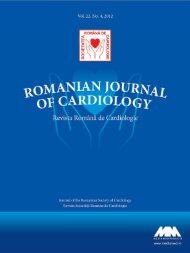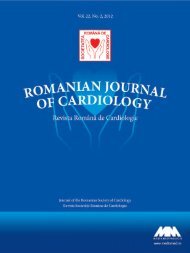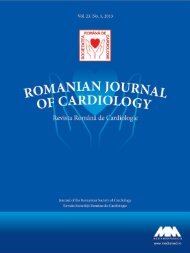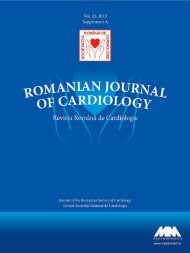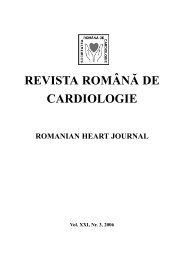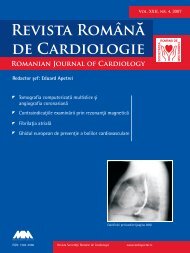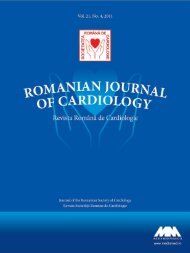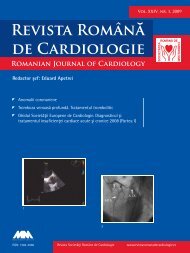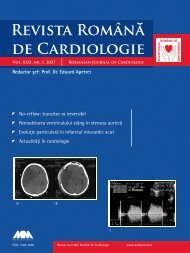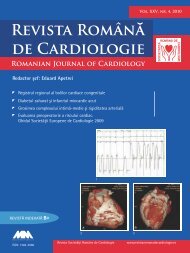Ghidul privind diagnosticul şi managementul sincopei - Romanian ...
Ghidul privind diagnosticul şi managementul sincopei - Romanian ...
Ghidul privind diagnosticul şi managementul sincopei - Romanian ...
You also want an ePaper? Increase the reach of your titles
YUMPU automatically turns print PDFs into web optimized ePapers that Google loves.
Cornelia Cãlinescu et al<br />
Risk factors for sudden death<br />
cant, was modest and variable between subjects and<br />
symptomatic relief was reported by patients in the presence,<br />
but also in the absence of pacing 1 .<br />
Th us, the European guidelines for the management<br />
of HCM patients recommend this therapeutic alternative<br />
only in elderly patients (older than 65 years), with<br />
obstructive HCM refractory to drug therapy, which can<br />
benefi t from the reduction of outfl ow gradient and improve<br />
exercise capacity (for which alternatives to surgery<br />
are oft en desirable) 3 .<br />
In our patient the eechocardiography performed<br />
one day aft er pacing did not show a reduction of the<br />
LV outfl ow gradient, but the patient is going to be reassessed.<br />
Due to severe concentric LV hypertrophy, septal artery<br />
embolization or septal selective surgical resection,<br />
remain to be re discussed in case no benefi cial eff ects<br />
are observed in a longer term 9 .<br />
Current trends are to believe that benefi cial eff ects of<br />
dual-chamber pacing in hypertrophic cardiomyopathy<br />
are signifi cantly more important in a long term: thus,<br />
although the initial reduction of the gradient in the left<br />
ventricular outfl ow tract may be insignifi cant, in the<br />
long run it may be substantial, because of left ventricular<br />
remodeling due to the dissynchronism achieved<br />
by pacing 10 .<br />
Th e most commonly accepted mechanism of gradient<br />
reduction aft er pacing in HCM remains the inversion<br />
of the ventricular contraction sequence as a<br />
consequence of right ventricular apical activation mimicking<br />
left bundle branch block leading to: widening<br />
of the left ventricular outfl ow tract; a decrease in the<br />
Venturi eff ect; and a decrease in systolic anterior motion<br />
of the mitral valve. Th e AV delays required to produce<br />
complete right ventricular pre-excitation is the<br />
crucial requirement for success of this treatment 11 .<br />
Th us, dual -chamber pacing requires review by randomized<br />
studies, and long-term follow-up should be<br />
considered in patients whose condition does not allow<br />
surgically therapy, septal ablation, patients that have<br />
moderate left ventricular hypertrophy, conventional<br />
<br />
<strong>Romanian</strong> Journal of Cardiology<br />
Vol. 26(21), No. 2, 2011<br />
pacing indications, or increased risk to develop heart<br />
block secondary to surgery or septal ablation 1,12 .<br />
Case Particularities<br />
- signifi cant biventricular myocardial hypertrophy<br />
with dynamic obstruction in the left ventricular<br />
outfl ow tract in the presence of an important family<br />
history of sudden death, required implantation<br />
of an ICD with dual chamber pacing in a<br />
young patient.<br />
Bibliography<br />
1. Carmen Ginghină. Cardiomiopatia hipertrofi că. In Mic Tratat de<br />
Cardiologie sub redacţia Carmen Ginghină, Editura Academiei Române,<br />
București, 2010, 345-355.<br />
2. Maron BJ. Hypertrophic cardiomyiopathy. In Braunwald’s Heart Disease:<br />
A Textbook of cardiovascular Medicine, 8th edition. Eds: Braunwald<br />
E., Zipes DP, Libby P, Bonow RO. Saunders Elsevier, 2008,<br />
1763-74<br />
3. Maron BJ, McKenna WJ, Danielson GK, et al. American College of<br />
Cardiology / European Society of Cardiology Clinical Expert Consensus<br />
Document on Hypertrophic Cardiomyopathy. Eur Heart J, 2003;<br />
24:1965–91.<br />
4. Muhammad Alamgir Khan, Muhammad Mazhar Husssain, Muhammad<br />
Aslam, Imran Majeed, Waqas Hameed. Frequency of Ventricular<br />
Late Potentials in Healthy Population. Pak J Physiol, 2007; 3(1).<br />
5. Barry J. Maron, MD. Contemporary Insights and Strategies for Risk<br />
Stratifi cation and Prevention of Sudden Death în Hypertrophic Cardiomyopathy.<br />
Circulation, 2010; 121: 445-456.<br />
6. Imke Christiaans, Klaartje van Engelen, Irene M. van Langen, et al.<br />
Risk stratifi cation for sudden cardiac death in hypertrophic cardiomyopathy:<br />
systematic review of clinical risk markers. Europace, 2010;<br />
12: 313-321.<br />
7. Gregoratos G, Abrams J, Epstein AE et al. ACC/AHA/NASPE -2002<br />
Guideline Update for Implantation of Cardiac Pacemakers and Antiarrhythmia<br />
Devices. Summary article: A Report of the American<br />
College of Cardiology/American Heart Association Task Force on<br />
Practice Guidelines (ACC/AHA/NASPE Committee to update the<br />
1998 pacemaker guidelines). Circulation, 2002; 106:2145-61.<br />
8. Barry J. Maron, Paolo Spirito, Win-Kuang Shen,et al. Implantable<br />
Cardioverter-Defi brillators and Prevention of Sudden Cardiac Death<br />
in Hypertrophic Cardiomyopathy. JAMA, 2007; 298 (4): 405-412.<br />
9. Apetrei E, Seggewiss H, Deleanu D, et al. Ablația miocardică septală<br />
percutanată în cardiomiopatia hipertrofi că obstructivă. Rev Rom<br />
Cardiol, 1999; IX: 134-40.<br />
10. Enrique Galve, Antonia Sambola, Germán Saldaña, et al. Late benefi ts<br />
of dual-chamber pacing în obstructive hypertrophic cardiomyopathy.<br />
A 10-year follow-up study. Heart, published online May 28, 2009.<br />
11. Alistair K B Slade, Nicolas Sadoul, Leonard Shapiro. DDD pacing în<br />
hypertrophic cardiomyoopathy: a multicentre clinical experience.<br />
Heart, 1996; 75: 44-49.<br />
12. Stephen P Page and Saidi A Mohiddin. Long Term Benefi ts of Pacing<br />
în Obstructive Hypertrophic Cadiomyopathy. Heart, publised online,<br />
2009 Nov.



